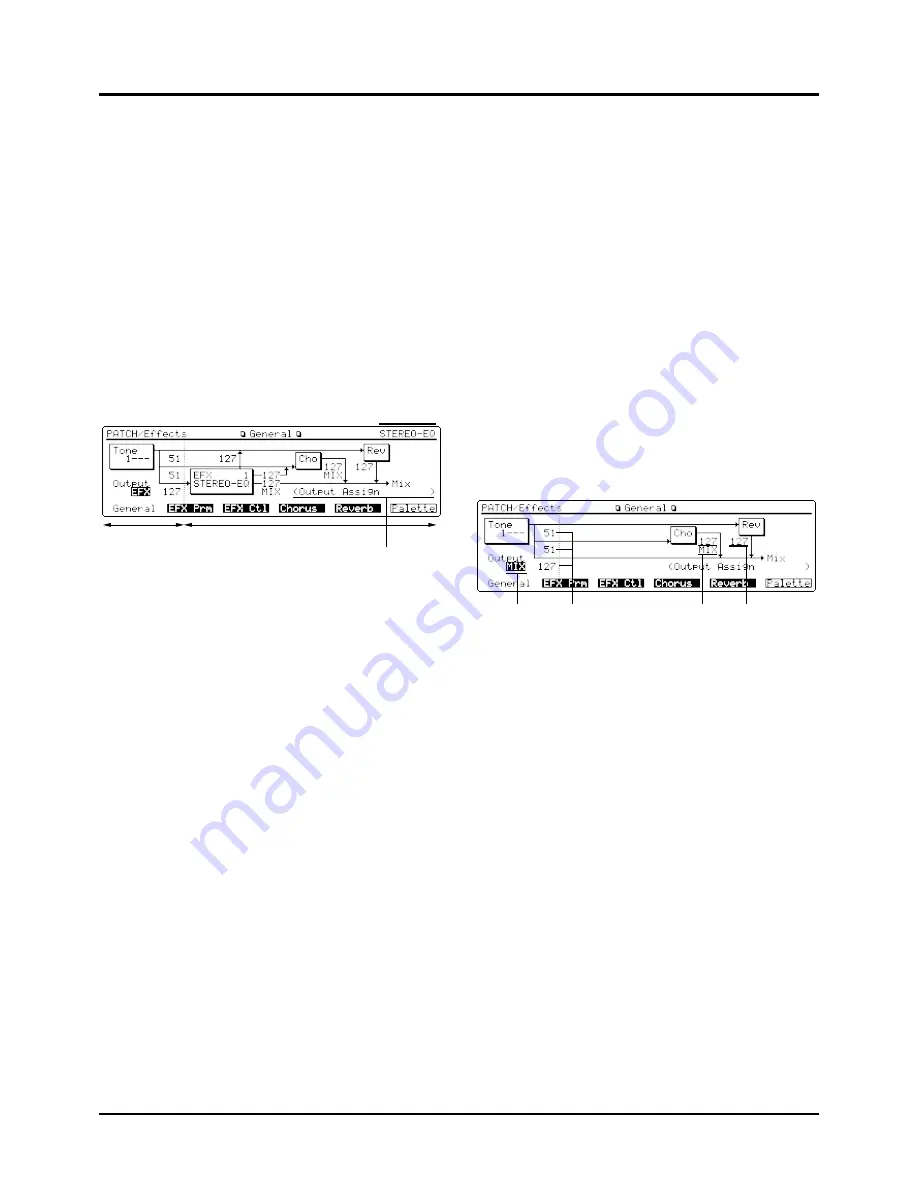
60
Setting effects for a Patch (Effects)
✳
With the Arpeggiator on, closing the Arpeggio win-
dow in the Play display (PATCH) will assign the func-
tion to re-open the Arpeggio window to [F6]. To set
effects parameters, hold down [SHIFT] as you press
[F6] to call up the relevant display.
...........................................................................................................
<Routing effects>
Deciding how you want the effects to be ‘connected’ (rout-
ing) depends mainly on how each Tone and effected sounds
are output. Set the routing, then send level of the signal that
is to be effected. At 0 level, nothing is sent and no effects are
connected.
The first step is to configure effects routing on the General
(Effects general) display. The basic procedure for deciding
effects routing is discussed below.
✳
The graphic display as well as parameters on display
will change with the settings.
(Basic Procedure)
❶
Press [EFX], [CHORUS] and/or [REVERB] to turn on
the effects you want.
Parameter settings have no effect unless you’ve turned on
the effects you want.
❷
Deciding Tone destination.
Use Output Assign to specify how each Tone is output. If
you want each Tone to go through EFX, select EFX and use
the Mix/EFX Send Level parameter to adjust Tone level.
❸
Adjusting Chorus and/or Reverb amount.
Make your basic Chorus and Reverb settings for each Tone
here.
For Chorus, set the Chorus Send Level parameter. Set it to 0
if you don’t want this effect.
For Reverb, set the Reverb Send Level parameter. Set it to 0
if you don’t want this effect.
✳
Detailed settings such as how chorus is to sound or is
output should be made on the Chorus display. Do the
same for reverb type, reverb time, etc. on the Reverb
display.
❹
Selecting EFX type.
If you’ve selected EFX in step 2, use the EFX Type parameter
to select EFX type.
✳
Detailed settings for the EFX type you’ve selected
should be made on the EFX Param display.
❺
Adding chorus or reverb to a sound that’s gone
through EFX.
If you want to apply chorus and/or reverb to the sound after
it’s gone through the EFX, adjust the amount of chorus and
or reverb using the EFX Chorus Send Level and EFX Reverb
Send Level parameters. If not, set it to 0.
❻
Deciding on the destination of sound that’s gone
through the EFX.
Use EFX Output Assign parameter to send it to the MIX
OUTPUT jack or DIR OUTPUT jack.
❼
Make fine adjustments for EFX, Chorus and Reverb to
adjust the balance between these effects.
...........................................................................................................
General (Effects general) display
Use this display to decide how effects are to be connected.
Parameters on display differ with the Output Assign para-
meter setting.
✳
If you have selected 2–10 for Structure Type 1&2 (or
3&4) parameters (PATCH/Common/Structure), Tone
1 (or 3) and Tone 2 (or 4) outputs are combined into
Tone 2 (or 4). Tone 1 (or 3) settings will be ignored.
Output Assign parameter set to MIX
Output Assign
MIX
: The direct sound is output to MIX OUTPUT jack. If
Chorus and/or Reverb is selected, these effects are output
together with the direct sound.
Reverb Send Level
Adjusts reverb intensity for each Tone.
Chorus Send Level
Adjusts chorus amount for each Tone.
Mix/EFX Send Level
Adjusts volume of each Tone.
Chorus Level
Adjusts volume level of chorus sound.
✳
This setting also affects the Level parameter value
(PATCH/Effects/Chorus).
Chorus Output Assign
Specifies how chorus sound is to be output.
EFX Type name
Parameter name with the cursor
Tone parameter
Parameters for each Patch
Output Assign
Chorus Level
Chorus Output Assign
Reverb Level
Reverb Send Level
Chorus Send Level
Mix/EFX Send Level
Chapter 3. Creating your own sounds
[PATCH]
➞
[F6] (Effects)
➞
[F1] (General)
Содержание XP-60
Страница 245: ...245 ...
Страница 248: ...OWNER S MANUAL 01458056 99 7 E3 51K ...






























